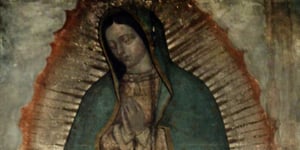On December 12, 1531, an image of Our Lady of Guadalupe appeared on the tilma of native Aztec, Juan Diego during his Marian apparition. Since then, scientists have struggled to explain just how the image got there.
The image itself has many extraordinary attributes that border on the miraculous (and probably indicate it!). In the 20th and 21st centuries, five attributes in particular have drawn scientific attention.
- The material of the Tilma
- How the Tilma was displayed
- The Tilma does not appear to be painted
- The Tilma's lack of decay
- The eyes on the Tilma
The Material of the Tilma
The material of the tilma has maintained its chemical and structural integrity for almost 500 years. This is quite remarkable! Most replicas of tilmas with the same chemical and structural composition last only fifteen years before decomposition.
How the Tilma was Displayed
For its first 115 years, the tilma was displayed without protective glass. This subjected it to soot, candle wax, incense, and touching. There is currently no scientific explanation for its physical and chemical longevity.
The Tilma Does not Appear to be Painted
There are several parts of the cloth which have been painted on some time after the original image was created. These parts include the moon underneath the Virgin’s feet, the angel holding the cloth, and the rays coming from the image.
The original image of the Virgin herself, however, does not appear to have been painted by an artist. There is no sketch underneath it, no brush strokes, and no corrections. It appears to have been produced in a single step. These features were identified through scientific testing conducted by Dr. Philip Serna Callahan, who was a biophysicist at the University of Florida, and a NASA consultant. He photographed the image under infrared light, and published his findings in 1981 in a paper called "The Tilma under Infrared Radiation."
The Tilma's Lack of Decay
Dr. Philip Callahan also noted that the original image on the tilma had not cracked, flaked, or decayed in over 500 years. The added paint and gold leaf had flaked or deteriorated considerably. This phenomenon has still not yet been scientifically explained.
The Eyes on the Tilma
The eyes of the Virgin have three remarkable qualities that cannot be explained through known technology in 1531. Each would be difficult even to replicate with today’s technology of computers, ophthalmologic knowledge, and digital photography.
-
Engineer Jose Aste Tonsmann, has amplified an image of the pupils of the Blessed Virgin by 2500 times. This allowed him to identify not only what appears to be the image of Bishop Zumarraga, but also several other witnesses of the miracle reflected there.
-
The images in the pupils also manifest the triple reflection called the Samson-Purkinje effect. This effect was completely unknown at the time of the image’s formation.
-
The image in the eyes of the Virgin follow the curvature of the cornea precisely in the way it occurs in a normal human eye.
Juan Diego's Tilma: A Remarkable Source of Conversion
Displayed in the Cathedral atop Tepeyac Hill in Mexico, the image of Our Lady of Guadalupe on Juan Diego’s tilma has been a remarkable source of conversion to Catholicism throughout Mexico.
The influence of this single devotion has been so great that, upon seeing the image for the first time in 1754, Pope Benedict XIV wept and uttered the words of Psalm 147, “God has not dealt in like manner with any other nation.”
*Originally published on August 31, 2020.

